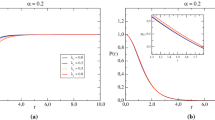Summary
The Newtonian gravitational field of a superconducting global cosmic string is investigated using the weak-field approximation, and is found to receive contributions from the global string field, the condensate field, and the electromagnetic fields. For certain parameter ranges the gravitational field in the region exterior to the string may be everywhere repulsive, everywhere attractive, or repulsive in some regions and attractive in others. For a neutral superconducting global string there can exist a particular current for which the gravitational field of the superconducting global string approximately coincides with that of a Grand Unified Theory (GUT) scale Weyl string, and, as pointed out by Widom, Srivastava, and Redington, observed asymptotic galactic rotation velocities can be roughly explained without the introduction of any further dark-matter hypothesis.
Similar content being viewed by others
References
E. Witten:Nucl. Phys. B,249, 557 (1985).
D. N. Spergel, T. Piran andJ. Goodman:Nucl. Phys. B,291, 847 (1987).
M. Aryal, A. Vilenkin andT. Vachaspati:Phys. Lett. B,194, 25 (1987).
H. B. Nielsen andP. Olesen:Nucl. Phys. B,61, 45 (1973).
A. Vilenkin andA. E. Everett:Phys. Rev. Lett.,48, 1867 (1982).
A. Vilenkin:Phys. Rev. D,23, 852 (1981).
A. Vilenkin:Phys. Rep.,121, 263 (1985).
D. Garfinkle:Phys. Rev. D,32, 1323 (1985).
M. E. Ortiz andF. Ruiz-Ruiz: inThe Formation and Evolution of Cosmic Strings, edited byG. Gibbons, S. Hawking andT. Vachaspati (Cambridge University Press, Cambridge, 1990).
B. Linet:Class. Quantum Grav.,6, 435 (1989).
C. H. Lee:Nuovo Cimento B,105, 875 (1990).
P. Peter andD. Puy:Phys. Rev. D,48, 5546 (1993).
O. F. Dayi, H. J. W. Muller-Kirsten, A. V. Shurgaia andD. H. Tchrakian:Phys. Lett. B,286, 234 (1992).
A. Widom, Y. N. Srivastava andN. Redington:Phys. Rev. D,48, 554 (1993).
We require (ϱV/ϱR, ϱV/ϱF)| R=η,F=0=(0,0) and (ϱ2 V/ϱR 2,ϱ2 V/ϱF 2│R=η,F=0>(0,0)..
Author information
Authors and Affiliations
Additional information
The author of this paper has agreed to not receive the proofs for correction.
Rights and permissions
About this article
Cite this article
Morris, J.R. Gravitational field of a superconducting global string. Nuov Cim A 107, 1715–1722 (1994). https://doi.org/10.1007/BF02780703
Received:
Revised:
Accepted:
Published:
Issue Date:
DOI: https://doi.org/10.1007/BF02780703



